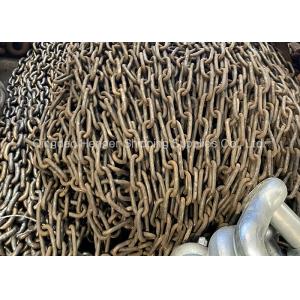

Add to Cart
Anchor chain is a special chain that connects the anchor to the hull and transmits the anchor grip. It is often composed of anchor end links, intermediate links and end links. According to the structure of the chain ring, it can be divided into two kinds of anchor chain with gear and without gear, the former is stronger than the latter; according to the manufacturing method, anchor chain can be divided into cast steel anchor chain and electric welding anchor chain, etc. The length of the anchor chain is measured in sections, and the standard length of each section is 27.5 m. The sections are connected by connecting links or connecting shackles. Usually the length of chain for each anchor is about 12 sections per side of a 10,000 ton vessel.
The anchor chain can be divided into Stud Chain and Studless Chain according to the structure of the chain ring.
1.Studded anchor chains have a cross-file in the chain ring. When the size and material are the same, the strength of the studded chain is greater than that of the studless chain, and the deformation is smaller, and it is not easy to twist and tangle when stacking.
2.The chain ring of non-geared anchor chains has no transverse gear and is only used for small vessels. The code stipulates that when the required anchor chain does not exceed 17mm in diameter, it can be replaced by an anchor chain with an equal test load, or a wire rope or fibre rope with an equal breaking load.
Anchor chains are available in cast steel, welded and forged
according to their manufacturing methods. Cast steel anchor chain
is strong, rigid, small deformation, wear-resistant, not easy to
loosen the cross-file, long service life, and suitable for mass
production. The disadvantage is that the process is complicated,
the cost is high and the impact resistance is poor. Welded anchor
chains are bent and welded from round steel materials that meet the
requirements. They have the advantages of advanced and simple
production process, low cost and good quality. Forged anchor chains
have good impact resistance and toughness, but the manufacturing
process is complicated, costly and the quality is unstable.
At present, welded anchor chains have been most widely used on
merchant ships. Anchor chains are almost always manufactured by
flash welding method, and casting anchor chains are less frequently
used. Forged anchor chains have been largely eliminated, except for
anchor chain accessories which are mostly forged parts.
Anchor chain accessories: Kent shackle, connecting shackle, A-type swivel shackle, B-type swivel shackle, end shackle, swivel.
The role of the anchor is mainly to fix and stabilise the boat. In terms of the following aspects.
1. For the anchor chain to work, the most basic condition is to
hook something at the bottom of the sea etc. If the anchor chain is not long enough, the anchor will not work.
If the bottom of the sea is flat, or the anchor hooks something
that is not fixed, or the hook is not too firm, if the wind and
waves are calm, it is OK, but once the waves are too big, causing
the anchor to hook something, it will make the anchor lose its
function, which is called "walking anchor", during the anchoring
period, there is a walking anchor, it is very dangerous, because
when the ship is at anchor, generally It is very dangerous for a
ship to drift around without power because the main engine is
stopped when the ship is at anchor and it takes time to start the
ship immediately. That is why the concept of anchorage was
developed. Anchorage, by implication, is rougher under the seabed
and, in addition, should be sheltered from the wind.
2. The weight of the anchor chain is negligible for the boat, the
friction is not much. Generally speaking, when anchoring a boat, the anchor chain is
straight, which is basically ignoring the effect of friction. If
you are on the beach, you will find a lot of small fishing boats
with thick ropes as their anchor chains.
3. Above the boat the anchor chain is straight, but underwater
there is a section that is close to parallel to the seabed
(actually against the sea floor). The anchor provides the grip, which is then transferred to the
ship through the chain to resist the effects of external loads from
currents, wind and waves on positioning. Think about it, an anchor
with a straight chain is prone to go off when pulled. Having a
section against the seabed provides a margin within which this is
possible.
